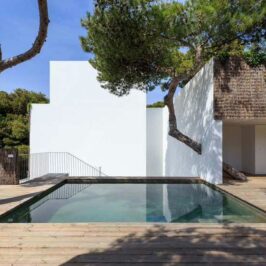Sustainable, and environmentally friendly Architecture: Future is here!
This is dry posidonia. Did you know that it was used to protect wood from the coffered ceilings in all of Palma’s stately homes between the 14th and 17th centuries?
It doesn’t rot. It doesn’t smell. We have posidonia samples from 600 years ago! It is an example of the wisdom of traditional architecture whose philosophy (and even its materials) we can recover today as part of our environmental and social commitment.
Life Reusing Posidonia prototype construction
It consists on a social housing development which is able to reach the proposed goals, especially the reduction of the CO₂ emissions to 300Kg / m² during construction of the works. Embodied emissions will be calculated on the finally built project by the beneficiary partner, from own studies, BEDEC bank, and studies already developed by “Societat Orgànica” Consulting ltd. The chosen solutions on this project have been selected among the best options in each case.
Why Life Reusing Posidonia?
Buildings pollute.
When you build them, the contamination is produced by manufacturing materials and production of rubble.
And when you use them, the contamination is produced by the energy to live in them.
Our proposal is to reduce pollution by 50% in manufacturing, 50% of waste production, and 75% energy for heating or cooling.
Therefore, we’ll recover techniques and materials from traditional architecture, and low-tech systems without sophisticated devices that use to get broken.
Not only for environmental issue, but also because we would live much better and costs nearly the same.

And if this is repeated widely, cities will be more friendly and nice.
It’s remarkable the use of dry Posidonia Oceanica, for thermal and acoustic insulation, thus hopes to demonstrate the feasibility of more environmentally-friendly forms of construction that can both reduce the emission of greenhouse gases and improve the quality of city-landscapes. We expect that the use of Neptun grass will increase its social interest and presence in the media.
The reduction of CO₂ in construction contributes directly and positively in protecting Neptune grass meadows, because of the danger they are subjected. According to the Higher Council for Scientific Research -CSIC- during XXI century, it will lose 90% of its density. This process would begin in about 40 years and it will become a functional extinction of the specie, with a moderately optimistic scenario emission of greenhouse gases.
Description and objectives
This project aims to demonstrate the feasibility of developing a multifamily residential building reducing the associated ecological footprint by the following percentages:
50% Energy consumption during CONSTRUCTION.
75% Energy consumption during USEFUL LIFE.
60% Consumption of WATER.
50% Production of WASTE.
The main innovative aspect is the 50% reduction of CO2 emissions during the execution of works. In order to do it, a proper selection of materials is proposed, preferably low embodied energy materials, recovering, insofar as possible, vernacular architecture techniques, as expressed in the following hierarchy:
1. Waste and local raw materials requiring negligible industrial processes.
2. Renewable green or raw materials with Certificate of Origin label.
3. Recycled materials or materials from other areas requiring low-consumption industrial processes.
Using the paradigm “Think global, act local”, we propose a model of hyper-local architecture, where every project becomes a map of resources of the area. This approach links environmental issues with the cultural tradition of each region, not only achieving an improvement in air quality and the prevention of global warming but also a recovery of the cities landscape quality.
This promotion was chosen from the very beginning as a pilot project in order to check and determine the real costs of a multifamily housing development that meets the requirements proposed by the Guide to Environmental Measures for Building in the Balearic Islands. This Guide was developed by IBAVI (Balearic Islands Institute for Housing) in collaboration with the company Societat Orgànica Environmental Consulting S.L.













Leave a Reply